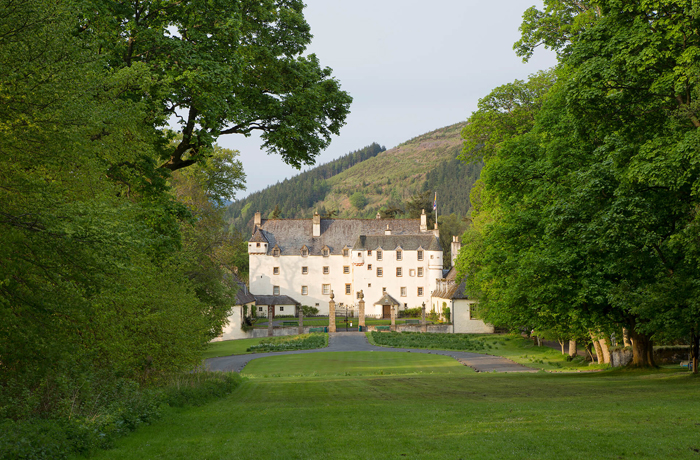Traquair House and Brewery
Scotland’s oldest inhabited house, Traquair House, tells a fascinating, 900+ year story of royal escapades, political intrigue, religious persecution, high-profile visitors, deterioration and visionary resurrection. And quite honestly, my goal with this article is to wet your travel appetite just enough to convince you to visit. Because the full story can only be heard through Traquair House’s structure, estate grounds, artifacts, ghosts and beer.
The name Traquair (pronounced truh KWAIR) comes from Celtic origin. Tret or tre mean a dwelling place or hamlet. And quair means a stream with a winding course. The Quair burn joins the River Tweed a few hundred yards from the rear of the house.
Brief History of Traquair House
Located south of Edinburgh, Scotland, Traquair House offers one of the most interesting stories in today’s active beer world. Originally a royal hunting lodge that dates back to 1107, twenty-seven Scottish Kings and Queens have visited the estate. Alexander I was the first Scottish king to stay and hunt at Traquair.
As noted by the Traquair House website, “During this period Traquair was nestled in the middle of the vast Ettrick Forest and provided a superb venue for royal hunting parties who came to hunt wild cat, wolves, deer, wild boar and bears who roamed the forest. A mural painting in the Traquair Museum dating back to the early 1500’s depicts some of these early hunting scenes.”
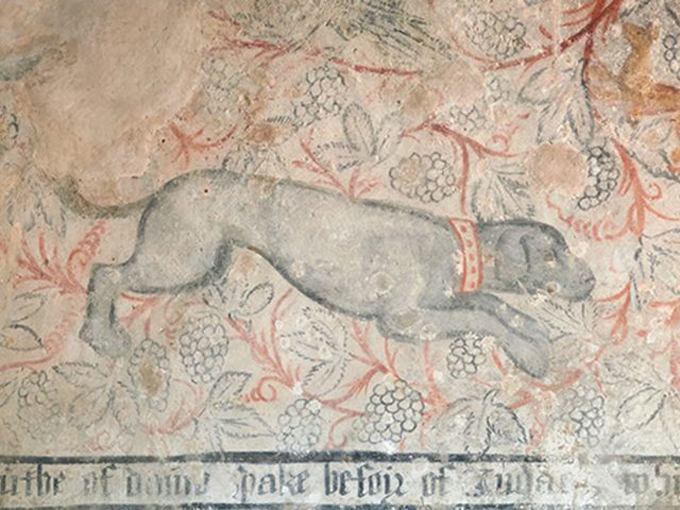 Image courtesy of Traquair House
Image courtesy of Traquair House
Later, when descendant Alexander III died in 1286, the peace of the region ended. Consequently, Traquair became a key link in the chain of defense that guarded the Tweed Valley against English invasion.
Over the next two centuries Traquair’s ownership changed often. But in 1491, the Earl of Buchan gifted the house and estate to his son, James Stewart, who became the 1st Laird of Traquair.
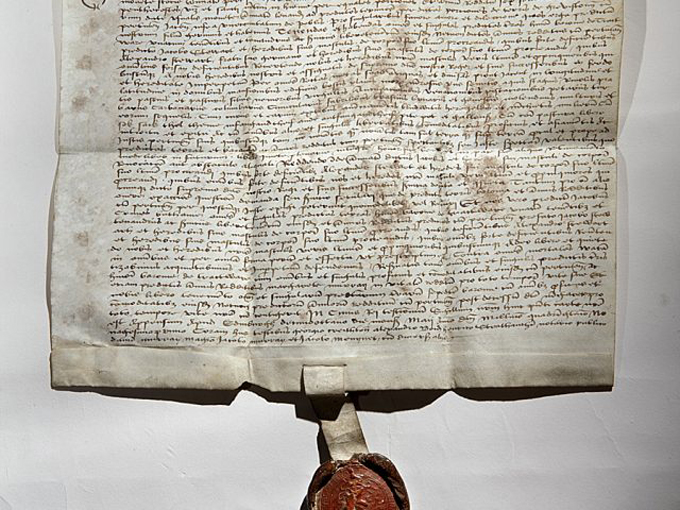 1491 Grant of Barony to James Stewart – image courtesy of Traquair House
1491 Grant of Barony to James Stewart – image courtesy of Traquair House
During the 1500’s and 1600’s, the Lairds of Traquair completed the main building. Rising to political power, John Stuart (formerly Stewart) , 4th Laird of Traquair, became Captain of the Queen’s bodyguard to Mary Queen of Scots. And Mary Queen of Scots, with her husband and baby son James, visited Traquair in 1566. Traquair operated a house brewery and served Mary Queen of Scots their famous strong ale during her visit.
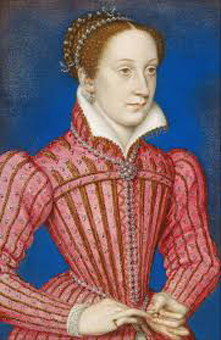 The cradle where Mary Queen of Scots rocked baby James, her bed and some other possessions can still be seen in the house.
The cradle where Mary Queen of Scots rocked baby James, her bed and some other possessions can still be seen in the house.
In 1633, King Charles I granted the 7th Laird, also named John Stuart, an Earldom. And in 1636, he rose to become Chief High Treasurer of Scotland. But John’s fidelity to the king and his attempt to bring Episcopacy to Scotland led to his downfall.
The second Earl of Traquair (also named John) established the family’s Catholic faith. His second wife, Lady Anne Seton was a strong Catholic. Despite the dangers involved, she was determined to bring her five children up as Catholics. The family held Mass in secret in a small chamber on the top floor. A secret escape route for the priest was hidden behind a concealed cupboard and led down the old stairs. The secret chamber continued to be used until the Catholic Emancipation Act in 1828. However, the family’s Catholic open faith forfeited any further chance of advancement.
The building of Traquair House was completed in 1695 by the Edinburgh architect James Smith. For over three hundred years there have been no additions or alterations to the main house.
However, the famous Bear Gates at the top of the main drive were built in 1739. When Prince Charles Edward Stuart, known as Bonnie Prince Charlie, fled Scotland from the English in 1745, the 5th Earl of Traquair locked the gates and promised they would never be opened again until the Stuarts returned to the throne. The gates remain locked to this day.
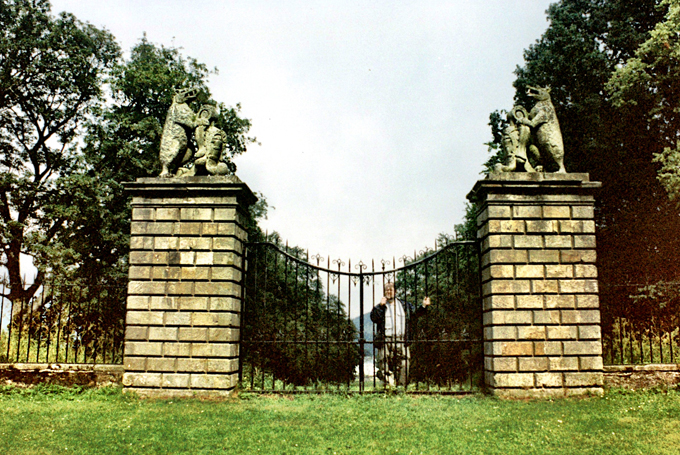 Visiting the Famous Bear Gates of Traquair House in 1996
Visiting the Famous Bear Gates of Traquair House in 1996
The Stuarts survived at Traquair until 1875 when Lady Louisa Stuart died unmarried. The earldom was lost and the house passed to her cousin Henry Constable Maxwell, who took the name Maxwell Stuart. Today Catherine Maxwell Stuart, 21st Lady of Traquair, lives with her family in the house.
Traquair House Brewery
For centuries brewing in the U.K. was primarily a domestic activity. During the eighteenth century most large country houses supported their own brewery as ale was considered a cheap and nutritional drink. Today, Traquair is an extremely rare example of one of these old estate breweries.
Brewing at Traquair originally took place in the kitchens of the house. However, in the early 1700’s the present brewery was established in one of the wings built in 1694. The brew house was furnished with a 200 gallon copper kettle bought in 1738 and wooden fermenting vessels made from Russian memel oak. The ale produced was either a strong dark ale or small beer which was made without using hops.
By the early 1800’s there were many more commercial breweries and brewing at Traquair became an expensive luxury the family could not afford. So the estate brewery was closed.
While spring cleaning, Peter Maxwell Stuart (the twentieth Laird) rediscovered the brewery in early 1965. He was surprised to find the entire collection of brewing vessels and equipment had survived intact. Peter enlisted the help of a friend, Sandy Hunter of Belhaven Brewery, and together they researched the Traquair archives and developed the recipe for a traditional Scottish Ale. The first brew took place in 1965 and the finished product was bottled at Belhaven and sold at Traquair. During the next few years the Laird continued brewing several times a year and he also numbered each bottle with a brew and bottle number.
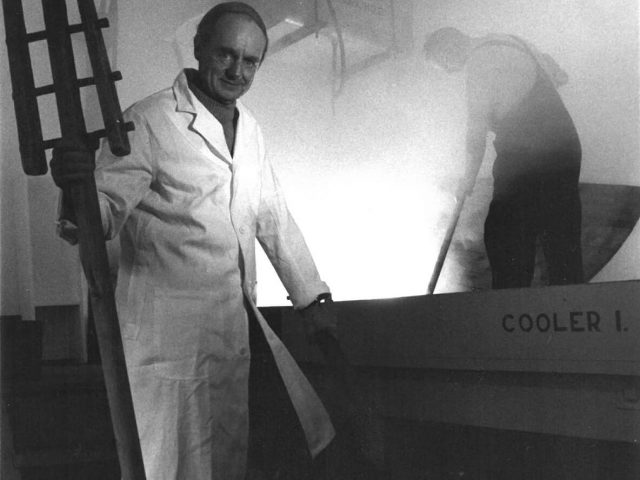 Peter Maxwell Stuart – image courtesy of Traquair House
Peter Maxwell Stuart – image courtesy of Traquair House
The copper brew kettle at Traquair is over 200 years old, and beer is made in the traditional manner — even using oak fermenting vessels, which contribute to the deep, unique character of these beers.
 Traquair is the only U.K. brewery using oak vessels for primary fermentation. – image courtesy of Traquair House
Traquair is the only U.K. brewery using oak vessels for primary fermentation. – image courtesy of Traquair House
In the 1970’s, Traquair’s ales gradually gained recognition thanks to world beer expert Michael Jackson and organizations such as the Campaign for Real Ale (CAMRA). Traquair was recognized as a pioneer of microbrewing. And by the mid-1980’s, Traquair Scottish Ales were exported to the United States.
Following Peter’s death in 1990, his daughter, Catherine (the 21st Laird), took over the running of the brewery. She expanded the brewery in 1994. Traquair employs two full time brewers and its rich dark ales are now exported all over the world with a current production of about 250,000 bottles per year.
The original ale produced in 1965 was The Traquair House Ale (ABV 7.2%). Traquair House Ale is still available today and now sold all over the world.
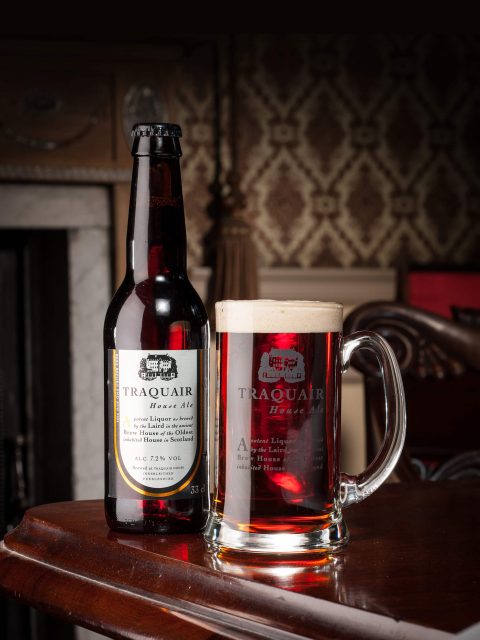 Image courtesy of Traquair
Image courtesy of Traquair
Brewed to celebrate the anniversary of the 1745 Jacobite rebellion, Traquair Jacobite Ale (ABV 8%) is spiced with coriander and based on an eighteenth century recipe.
Traquair Bear Ale (ABV 5%), Traquair’s original draught ale, was bottled for the first time in 1996 and is increasingly popular amongst those looking for lighter ale with the unique Traquair flavor.
In addition, limited edition beers are produced for seasonal or special occasions.
A Journey Through Time
Albert Einstein once wrote “…the distinction between past, present and future is only a stubbornly persistent illusion.” Having a beer (or two) at Traquair House can provide you the opportunity to slightly pull back that curtain of illusion and connect with the past while enjoying the present.
